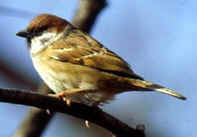Tree Sparrow(Passer montanus)
Habitat: towns, villages and fields.
Feeding habits: peck seeds or catch insects with bills.
 Food: seeds of crops and grass, part of insects. Food: seeds of crops and grass, part of insects.
Size: with a full body length of 14 cm; weight: 20-25 g.
Habits: resident bird. Sparrows like to act in groups and to seek for food in fields, grassland, hay ground, grain barns and draught animals' sties. They build their nests in cracks of tiles, holes on walls and holes of trees. Normally, they feed on seeds. When they feed their young, they will catch worms for them. Their cries are chaotic and varied. In the 1950s, sparrows were regarded as harmful birds and were killed in large amount. After the killing of sparrows stopped in the early 1960s, the number of sparrows recovered very quickly. In the wake of use of large amounts of pesticides, the number of sparrows reduces greatly. In many country places in South China, people can no longer see any sparrows.
Category: Ave, Passeriformes, Ploceidae
Distribution: all around Yunnan and China.
 
|